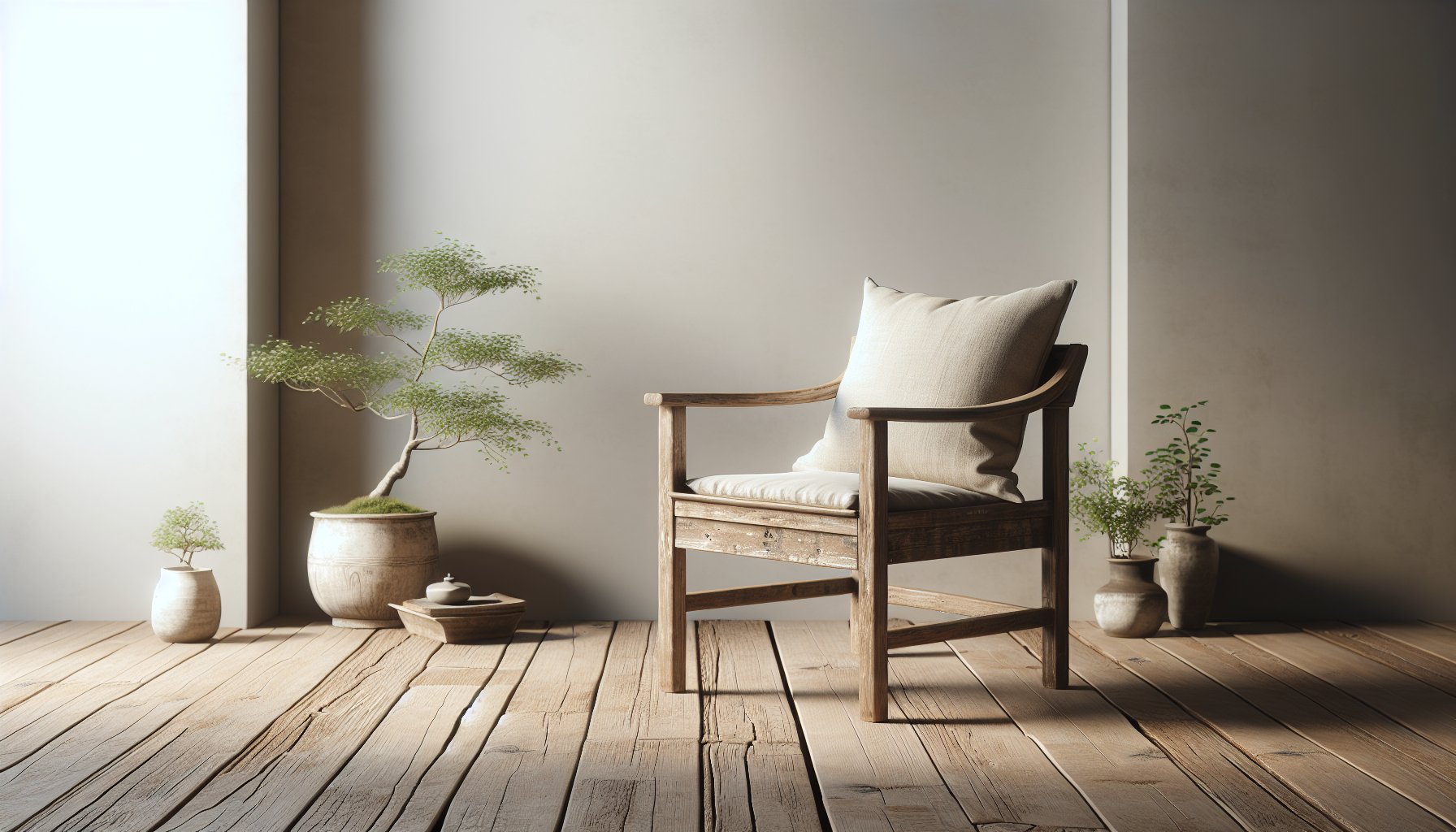Can you really integrate second-hand furniture into Japandi design and maintain that perfect balance of minimalism and warmth? Absolutely! Second-hand furniture can add character and sustainability to your space, all while aligning with the core principles of Japandi style. Let’s explore how you can achieve this harmonious blend in your home.
Understanding Japandi Design
Japandi design is an invitation to a tranquil yet functional space. It marries the minimalist tranquility of Japanese aesthetics with the cozy, rustic elements of Scandinavian design. The result is a serene environment that emphasizes natural materials, earthy tones, and a strong connection to nature.
Key Principles of Japandi Style
Incorporating the essence of Japandi is key to creating a harmonious, clutter-free living space. Here are the key principles you should keep in mind:
- Minimalism: Less is more in Japandi design. Each item must serve a purpose and bring joy.
- Natural Materials: Emphasize wood, stone, and linen. These elements add warmth without overwhelming the senses.
- Neutral Color Palette: Think soft whites, beiges, and muted tones. This creates a calming environment.
- Functional Design: Furniture should be both beautiful and practical, ensuring ease of use in everyday life.
Understanding these principles will help you thoughtfully choose second-hand pieces that fit into this aesthetic.
Finding Second-Hand Furniture
Before you begin furnishing your home, let’s discover where you can find second-hand furniture that resonates with the Japandi ethos. There are several resources, both online and locally, that can be treasure troves.
Local Thrift Stores and Flea Markets
One of the best places to find unique, character-filled pieces is in your local thrift shops or flea markets. You may stumble upon vintage wooden furniture or unique textiles that align beautifully with Japandi design.
Online Marketplaces
In today’s digital world, websites like Craigslist, Facebook Marketplace, or even specialized sites like Chairish or AptDeco offer an endless variety of second-hand furniture. Here, you can search by style, material, or color to find that ideal piece.
Estate Sales and Auctions
Estate sales can be another goldmine for discovering unique pieces that have history and character. Attending local auctions can also yield some surprising finds that fit perfectly with the Japandi aesthetic.
Friends and Family
Don’t overlook your network! Sometimes friends and family may be looking to part with furniture that could seamlessly integrate into your design. It’s not just a budget-friendly option; it also adds sentimental value.
Evaluating Second-Hand Furniture
Once you have a potential piece in mind, the next step is evaluating whether it fits into your Japandi design. Here are some factors to consider:
Condition of the Furniture
Before making a purchase, closely examine the condition. Look for structural integrity, signs of damage, and the overall craftsmanship. Durability ensures that your investment will stand the test of time and align with the functional aspect of Japandi style.
Material Quality
Japandi emphasizes natural materials, so check if the item is made from wood (preferably sustainably sourced), organic fabrics, or other eco-friendly materials. Items made from synthetic materials may not combine well with the organic feel you’re aiming for.
Form and Function
Is the furniture piece functional? Japandi design values practicality, so assess whether the item will serve a purpose in your living space. A beautiful bench can also be used for seating or as a decorative element.
Aesthetic Harmony
When evaluating a piece, consider how it fits into your overall color palette and design vision. Does it complement other items in your space? Does it evoke the serene feeling of your desired Japandi aesthetic?
Essential Second-Hand Furniture Pieces for Japandi Design
Now that you know how to find and evaluate second-hand furniture, let’s discuss a few essential pieces you should consider. Each of these items serves the dual purpose of functionality and aesthetic appeal.
Tables
Tables, whether for dining or living areas, are central to any home. In Japandi design, a simple wooden table can anchor the space.
- Coffee Tables: Look for low-profile, wooden coffee tables with clean lines. They can be used for serving tea or displaying decor while maintaining the minimalistic vibe.
- Dining Tables: Choose a sturdy table that reflects the natural grain of the wood. The dining area should feel inviting yet calm, perfect for gatherings with friends and family.
Chairs
Comfortable seating is essential. Focus on ergonomic designs that promise stability and style.
- Dining Chairs: Simple, wooden dining chairs without excessive ornamentation fit well in a Japandi dining space.
- Accent Chairs: Consider a comfy armchair in a neutral tone, perfect for corner reading nooks or relaxation spots.
Storage Solutions
Keeping a clutter-free environment is key to Japandi design, so strategic storage options are necessary.
- Shelving Units: Open shelving made from natural wood can display decorative items while providing functional storage. Look for designs that allow you to create a harmonious display of ceramics, books, and plants.
- Dressers and Cabinets: A mid-century modern dresser can be both elegant and practical, offering storage while exuding the warmth characteristic of this design style.
Decor Items
While furniture is vital, don’t forget smaller decor items that can enhance your Japandi aesthetic.
- Textiles: Look for vintage linen or cotton throws and cushions to introduce warmth without overwhelming the minimalist approach. Subtle patterns can add visual interest.
- Ceramics and Pottery: Handmade pieces or unique second-hand ceramics can add a personal touch. These items can be vibrant focal points in an otherwise muted environment.
Styling Second-Hand Furniture in Japandi Spaces
Once you’ve gathered your second-hand finds, styling them correctly is crucial to achieving that refined Japandi look. Let’s look at some effective tips for arranging your furniture and decor.
Create Balance
A well-balanced room is a hallmark of Japandi design. When arranging furniture, pay attention to the scale and proportion of items. For instance, a large dining table pairs beautifully with simple chairs to provide harmony.
Incorporate Nature
Bringing nature indoors is essential to Japandi design. Arrange your second-hand furniture to facilitate this connection. Place natural plants on tables or shelves to breathe life into the space, or use wooden planters to keep the organic theme.
Layer Textures
Combining different textures elevates the room’s visual interest while maintaining a tranquil vibe. Pair smooth wooden surfaces with soft textiles and textured ceramics for a cozy yet balanced look.
Use Negative Space
In Japandi design, negative space is just as important as the furniture itself. Allow for breathing room between pieces to enable each item to shine, creating an airy feel that emphasizes the principles of minimalism.
Sustainability and Ethical Considerations
One significant benefit of incorporating second-hand furniture into your home is the sustainability aspect. By choosing previously owned items, you significantly reduce waste and the demand for new furniture production, thus contributing to environmental conservation.
Eco-friendly Choices
Look for furniture made from sustainable or reclaimed materials whenever possible. This not only aligns with the environmental philosophy but also fits nicely with the natural theme of Japandi design.
Supporting Local Communities
Shopping locally for second-hand pieces supports your community and often leads to more unique finds. When you buy furniture from local thrift stores or estate sales, you contribute positively to local economies.
Personalizing Your Japandi Space
While Japandi design emphasizes simplicity, you can still add your personal touch to the space. Integrate sentimental items, artwork, or family heirlooms that resonate with you. This infusion of personal history provides warmth and makes your space uniquely yours.
Choosing the Right Accessories
Select accessories thoughtfully to enhance the overall aesthetic. Artwork should align with the color palette and not overwhelm the simplicity of Japandi. Consider using local artists or personal photography that tells a story.
Making Use of Color
While muted tones define Japandi, don’t hesitate to use color strategically to create focal points. A daring artwork or a subtle colored vase can be excellent ways to introduce splashes of color without overpowering the neutral foundations of the space.
Elements of Contrast
Incorporate elements of contrast to enrich your design. For instance, pairing a sleek, modern table with rustic, vintage chairs creates visual intrigue. The blend of old and new, organic and manufactured reflects the essence of Japandi design.
Maintaining Your Japandi Space
Creating a serene and functional Japandi environment requires ongoing maintenance to ensure everything looks its best.
Regular Cleaning
Implement a regular cleaning schedule to keep surfaces free of dust and clutter. This practice not only maintains aesthetics but also supports the calming atmosphere that Japandi aims to evoke.
Mindful Refurnishing
As your style evolves or you find new treasures, reflect on the items you have. Ensure everything still aligns with your vision of tranquility and functionality. If something no longer serves a purpose, consider donating or selling it to make space for new pieces.
Conclusion
Utilizing second-hand furniture can beautifully blend with Japandi design, creating a cozy and serene atmosphere. With careful selection and styling, you can craft a space that reflects both your personal taste and the calming principles of this aesthetic. Choosing previously loved pieces not only enriches your home but also contributes to a more sustainable future. As you gather your unique finds, remember that Japandi is about balance, functionality, and a deep connection to nature. So, are you ready to give your home the warm, minimalist touch of Japandi design through second-hand treasures? Happy decorating!

